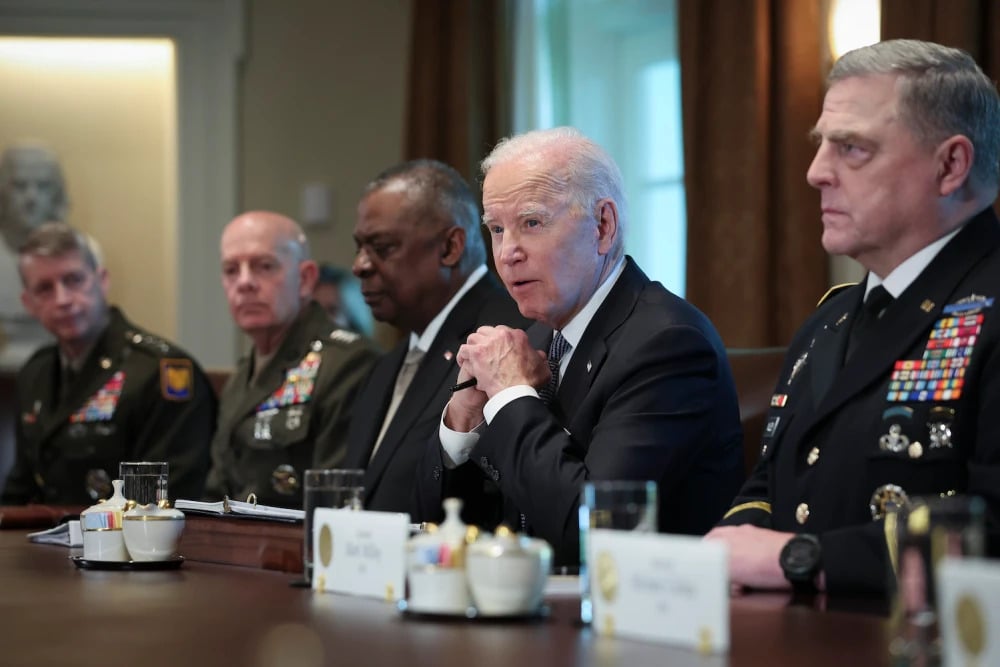U.S. imperialism under Biden has come a long way since the humiliating military withdrawal from Afghanistan in August of 2021. The withdrawal, which constituted the administration’s first big foreign policy move, caused Biden’s approval rating to plummet by 10 percentage points in one month and set off a frenzy of international commentary about declining U.S. hegemony and military power.
Along with this display of U.S. decline and incompetence, Biden’s foreign policy agenda was limited by his difficulty re-establishing key alliances degraded during the Trump years. Then, in March 2022, Russia invaded Ukraine, and the Biden administration’s constant refrain of “democracy vs. authoritarianism” — a line as hypocritical as can be — held more weight. Facilitated by Russia’s invasion, the Biden administration has been able to move forward on one of its main tasks: re-establishing the international power of the United States in service of U.S. capital’s interests.
To restore U.S. global hegemony, the Biden administration is advancing a strategy to pursue long-term conflicts with an eye towards confrontation with China. Escalatory moves against regional powers like Russia can be understood as part of this strategy. This pursuit of long term conflict was advanced by the passage of the $858 billion 2023 National Defense Authorization Act (NDAA), which passed with bi-partisan support.
The task Biden faces and his successes so far are riddled with limits and contradictions. If 2022 has shown one thing, however, it is that no one should underestimate the survival of U.S. imperialism, or how far its leaders will go to remain dominant.
The War in Ukraine — Already a Victory for U.S. Imperialism
Putin’s invasion of Russia has been a gift for U.S. imperialism. The invasion quickly developed into a proxy war between Russia and NATO. By getting the Zelenskyy regime to lead the war effort, Western imperialist powers have been able to avoid the costs of putting boots on the ground, while still using their overwhelming forces to weaken Russia militarily. According to estimates by the Center for Strategic and International Studies, the United States alone has sent more than $30 billion in military aid to Ukraine in what is now the largest arms transfer in U.S. history. Not only has the United States used the invasion to revive NATO, it has achieved a historic expansion of the military alliance.
All signs point to the United States continuing, and even increasing, its involvement in the proxy war. The just-passed NDAA allows the Pentagon to grant noncompetitive, no-bid, multi-year contracts to weapons manufacturers to produce weapons systems specifically for Ukraine. To be clear, this is an uncommon contracting arrangement designed for further militarization of U.S. policy: the Pentagon is eroding existing measures that limit military spending with a stated intention of increasing the military power of Ukraine to fight Russia. The United States has even established a new military command to oversee involvement in Ukraine, understood by military analysts as a sign of long-term commitment to this war.
Even if the war does end sooner, the U.S. advance in Europe will endure. From here on, Russia will neighbor a Ukraine armed to the teeth with NATO weapons. The U.S. military presence throughout Europe will remain, with hundreds of thousands of additional U.S. troops stationed in various European countries, including a new permanent base in Poland established as a result of this war. It is also likely that the war will end with NATO directly at Russia’s border, as Finland and Sweden are on their way to formally entering the alliance.
The Contradictions of Biden’s Ukraine Policy
Of course, NATO has its own weaknesses. From the start of the war in Ukraine, the United States has been unable to win the support of key allies such as India, Mexico, Brazil, Israel, and Saudi Arabia. In some cases, the war has even moved strategic partners of U.S. imperialism closer to Russia, most notably India and Saudi Arabia. Strong alliances are not guaranteed even on the European front. Underlying NATO’s presentation of strength and unity are conflicts between the countries of Western Europe like France and Germany — for which a continuation of the war poses a more existential threat — and the United States, which seems interested in going as far as it possibly can to militarily weaken Russia. These conflicts will deepen as Europe heads into winter with Germany, France, and other countries lacking heat now that they cannot rely on Russian gas. Additionally, many analysts predict that winter conditions will strengthen Russia on the battlefield.
Zelenskyy is also emboldened to flex his power, which poses a problem for NATO. This war has enabled Zelenskyy to crush the independence of Ukraine’s working class and achieve international prestige. Wielding this power, he has attempted to escalate the war beyond NATO’s interests. This conflict played out when a Ukrainian misfire hit Poland, killing two civilians. Even after Poland and the United States confirmed that the missile came from Ukraine, Zelenskyy publicly contradicted his allies, insisting the missile was from Russia. Zelesnkyy is also leading Ukraine in a more offensive approach to the war, recently attacking targets deep in Russian territory.
Continuation of the war risks greater conflicts within NATO, escalation beyond Biden’s interests, and greater instability leading to a possible rise in class struggle or the influence of the Far Right — both of which are already on the upswing in Europe. NATO now must also deal with the crisis created by Zelenskyy — the leader NATO tied its war aims to — attempting to drag the alliance into a more aggressive position. All this has sparked debate within U.S. imperialism, with some sectors calling for diplomacy and others urging for the continuation of the war.
However, within the debate among the imperialists, the more escalatory sectors hold the greatest influence over Biden’s Ukraine policy. General Mark Milley, one of the main representatives of the imperialists who prefer de-escalation in Ukraine, recently made public statements in support of negotiations with Russia. His remarks were met with a swift response from hawks, with pro-escalation figures writing a range of criticisms of Milley in the bourgeois press. But Biden does not need to read the bourgeois press to know that de-escalation remains an unpopular position among imperialists. Two of his top advisors, Secretary of State Antony Blinken and National Security Advisor Jake Sullivan, oppose the path of de-escalation.
How the war plays out over the coming winter will likely inform what course Biden’s Ukraine policy takes in 2023. But as it stands, the likelihood of the conflict continuing for some years is far greater than a turn to diplomacy. Continuation of war breeds escalation in a vicious cycle. At a certain point, it will be impossible for the United States to back out of this war even if that is more beneficial for imperialist stability. In fact, the United States may have already passed a point of no return.
Whatever happens, the advances already made by U.S. imperialism are emboldening the most hawkish of its sectors. This makes Biden more likely to take aggressive measures not just towards Russia, but also against U.S. imperialism’s primary adversary — China.
China — A Long Confrontation Advances
While different sectors of imperialism continue to debate how the United States should deal with regional adversaries like Russia, they are all in agreement that the United States must focus on containing China’s growth. China was the primary concern in Biden’s National Security Strategy and the Pentagon’s 2023 budget proposal. For the first time, NATO has also listed China as a “challenge,” though this is more a reflection of the United States’ goals than any serious commitment from the European powers. However, it cannot be denied that the United States is moving forward with a long-term strategy to more aggressively confront China. What does such a strategy require?
Before the United States can commit to direct conflict with China, it will need to decouple the two economies. Biden has moved forward on this task, spending billions to establish domestic chip manufacturing for essential economic advantage over China. However, more notable is an escalatory move Biden made this October, when the administration placed unprecedented restrictions on China’s ability to access semiconductors and the equipment used to make them.
The decoupling will be a long, imperfect process. Already, Biden’s economic moves against China have put him in conflict with important allies such as Germany and France, two countries that cannot afford economic conflict with China. Beyond U.S. relations with Europe, any economic instability the decoupling causes will fall on the working class, opening space for greater class struggle in the United States and internationally. There is no way for the United States to decouple without risking a greater crisis, but the Biden administration has chosen to take the risk and likely cannot turn back.
Biden has also pursued a strategy of military containment in the Pacific, relying on strong alliances with governments in Japan, South Korea, Australia, India, and the Philippines to keep China in check. The United Kingdom has also entered into the containment strategy through the AUKUS alliance. In strengthening its own military presence with U.S. forces and proxies in the region, the United States is escalating long-standing tensions that could set the region on an increasingly unpredictable path. A recent example of this dynamic was Nancy Pelosi’s trip to Taiwan. This was an escalation towards China, breaking U.S. neutrality over Taiwan and signifying open hostility to Beijing. China responded with a series of military exercises around Taiwan.
Pelosi’s move and possible escalations to come can be better understood through the crisis of the two parties in the United States. Democrats and Republicans remain highly polarized; both are going to extremes to present themselves as the best party to serve the interests of capital. Despite the polarization, confronting China is one of the few positions where the two parties are in agreement. In fact, it is partially because of this agreement that the Democrats have taken a more recklessly interventionist posture towards China. They have to demonstrate that they, not the Republicans, are the party most willing to take on China. Since the Republicans became known for their chauvinist anti-China rhetoric and escalatory policies during the Trump years, the Democrats are forced to take even more aggressive positions.
Any weakness seen in China’s domestic political landscape or regional standing could embolden the United States to step up escalations to appease the most hawkish sectors of imperialism. The escalations around Taiwan are set to continue. DefenseOne reports that Taiwan is mentioned 438 times in the NDAA, far more than the 237 mentions of Russia or 159 mentions of Ukraine. In fact, the NDAA includes the Taiwan Enhanced Resilience Act which provides the island with $10 billion in military aid over five years and includes measures to accelerate Taiwan’s procurement of weapons and develop programs to train its military forces.
Biden’s meeting with Xi Jinping at the G20 summit indicated that despite all these escalations, neither the United States nor China are interested in direct conflict at this point in time. But the two powers cannot continue to grow indefinitely together. They are on a trajectory for greater clashes that would be of world historic proportions. The less the two economies are intertwined over time and the more U.S. militarization of the Pacific fuels regional conflict, the more likely a temporary flare-up like Pelosi’s inflammatory trip to Taiwan could spark another proxy war, or even advance the world towards a hot conflict between the two powers.
Contradictions of Imperialism and Prospects for Class Struggle
It would be a mistake to underestimate U.S. imperialism, but that doesn’t mean there aren’t real weaknesses that Biden will have to navigate. As noted above, every move he makes to escalate conflict comes with risks, some of which are unpredictable.
Already the war in Ukraine has greatly exacerbated the global economic crisis. While the United States has been relatively insulated from the worst impacts, a recession has long been on its way. The midterms demonstrated the Democratic Party’s capacity to recover popular support following the overturn of Roe v. Wade, but voters still noted inflation as their primary concern in exit polling. Republican leaders have already begun moving away (at least rhetorically) from “unlimited” support for Ukraine. Public support for weapons shipments to Ukraine remains high. A recent poll conducted by the Chicago Council on Global Affairs, however, indicates that support for indefinite aid is slipping, with 47 percent of Americans surveyed saying Washington should urge Kiev to settle for peace as soon as possible. It is not unlikely that by 2024 the inflation crisis could develop enough in the United States for Republicans to rally voters around opposition to the war and its economic toll.
Even before class anger over the war significantly impacts the political situation in the United States, Biden will have to respond to its consequences internationally. Already we are seeing uprisings against rising cost of living throughout the Global South, with massive protests from Sri Lanka to Haiti, and movements forming around opposition to the imperialist IMF. This state of affairs will create more challenges to broad stability of U.S. interests around the world.
Most notable, however, is the impact the war is having on Europe. The working class of Europe is already suffering, spurring various crises for the traditional parties of capital throughout Europe. In some countries, such as Italy, class anger has been used to strengthen the Far Right. But the war has also given labor movements and Leftists the ability to wage historic fights in some of the strongholds of neoliberalism, such as in the United Kingdom and France. With Western European capital facing its own crises, it is no wonder countries such as Germany and France are attempting to distance themselves from U.S. imperialism and have grown more critical of the United States’ desire to prolong the war in Ukraine and decouple from China.
Biden cannot restore U.S. hegemony without beginning the long process of preparation for conflict now. But this preparation will force him to balance U.S. diplomacy with necessary military and economic alliances, maintain stability for U.S. interests throughout the semi-colonial world, and keep the Democrats ahead within the crisis of the two party regime of the United States.
Under Biden, the United States is in a moment of relative strength compared to its position during the Trump years. However, 2023 leaves plenty of room for crises to develop for the Biden regime. The working class in the United States is growing in consciousness and militancy, and this, more than anything, has the power to disrupt the aims of U.S. imperialism.
Notably, class struggle in the United States, while disruptive to the aims of capital, is not inherently anti-imperialist. In recent history, U.S. labor activity has been chauvinist, with signs on picket lines calling to “Protect American jobs.” By and large, labor has focused on bread and butter issues for the U.S. working class while avoiding fights against systems of oppression at home and abroad. This lack of internationalism emanates, in part, from the traditional labor bureaucracy’s connection to the imperialist Democratic Party. Even “Socialists” like Bernie Sanders and the DSA lean into a U.S.-centric vision of labor power. But it is wrong to believe that the power of the U.S. working class can best advance through a labor movement that is only national in scope. Self-division of the working class by countries and borders undercuts one of its greatest strengths, the sheer numbers it has to fight as an international force.
For workers in the heart of imperialism to take advantage of our full power, we will need to unite with our class siblings mobilizing around the world. This means building solidarity with strikes in other countries, firmly denouncing chauvinist slogans from labor leaders, mobilizing in our workplace and in the streets against U.S. intervention throughout the world, and understanding the international nature of our struggle against inflation.
Because we cannot count on even the most left-wing elements of the Democratic Party or the union bureaucracies connected to the party, we need leaders from our class who put forward an internationalist, anti-imperialist perspective in the U.S. labor movement. Since the two parties of capital are also parties of imperialism and war, the United States needs a working class party that is firmly anti-imperialist and seeks to unite our struggle with workers around the world, especially countries targeted by the United States.
Without such a party or internationalist perspective in the domestic class struggle, it is likely that U.S. imperialism will remain emboldened and take ever more aggressive, destructive actions. However, the weaknesses of the regime are there. It is the task of workers and the Left to use the crises of capital and the weakness of U.S. imperialism to our advantage.











